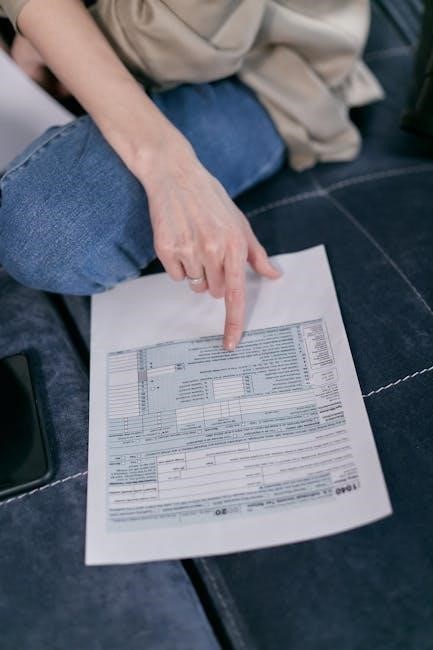Form 8985 is used to summarize and transmit Forms 8986, Partners Share of Adjustment(s) to Partnership-Related Item(s), by an audited partnership.
What is Form 8985?
Form 8985 is a tax document used by audited partnerships to summarize and transmit Forms 8986, which detail each partner’s share of adjustments to partnership-related items. It serves as a central form for reporting these adjustments, ensuring compliance with IRS requirements. Introduced under the Tax Cuts and Jobs Act, Form 8985 is crucial for partnerships undergoing audits, as it streamlines the process of reporting changes to partnership items. The form is typically filed by the partnership representative and is essential for maintaining accurate tax records and facilitating communication with the IRS during audits.
Purpose of Form 8985
The primary purpose of Form 8985 is to collect and report adjustments to partnership-related items following an audit. It ensures partnerships provide detailed information about each partner’s share of these adjustments, facilitating compliance with IRS requirements. By summarizing data from Forms 8986, Form 8985 helps the IRS understand the distribution of adjustments and verify the accuracy of tax liabilities. This form plays a critical role in maintaining transparency and accountability in partnership audits, ensuring all parties adhere to tax regulations under the Tax Cuts and Jobs Act.

Structure of Form 8985
Form 8985 is divided into sections for partnership details, itemized adjustments, and partner-specific information, ensuring organized reporting of audit-related changes for IRS review and processing.
Sections of Form 8985
Form 8985 is structured into clear sections to ensure comprehensive reporting. The first section collects partnership details, including the name, EIN, and tax year. The second section lists adjustments to partnership-related items, detailing each change. A third section provides partner-specific information, ensuring each partner’s share of adjustments is accurately reported. Additional sections may include explanations or supporting documentation for complex adjustments. The form concludes with a signature section for the partnership representative, ensuring compliance and accountability. Each section is designed to streamline the reporting process and provide the IRS with a transparent overview of audit-related changes.
Key Components of the Form
The key components of Form 8985 include the partnership’s identifying information, a detailed list of adjustments, and partner-specific data. The form requires the partnership’s name, EIN, and tax year to be clearly stated. Adjustments to partnership-related items are meticulously listed, ensuring transparency in reporting changes. Partner-specific information is also included to accurately reflect each partner’s share of adjustments. Additionally, the form may require explanations or supporting documentation for complex adjustments, ensuring clarity for the IRS. Finally, a signature section is essential, authorizing the submission by the partnership representative. These components collectively ensure accurate and compliant reporting of audit-related changes.

Step-by-Step Guide to Completing Form 8985
Complete Form 8985 by gathering partnership details, listing all adjustments, and verifying each partner’s share. Ensure accuracy and compliance with IRS guidelines for a smooth submission process.
Gathering Necessary Information
To complete Form 8985, gather partnership details, including the Employer Identification Number (EIN) and business name. Collect all relevant adjustments and partner-specific data from Form 8986. Ensure accurate figures for each partner’s share of adjustments, referencing Schedule K-1 if needed. Organize records of partnership-related items and any prior tax filings. Verify the correctness of each entry to avoid errors. Consult IRS guidelines for specific documentation requirements. Ensure all information aligns with current tax laws and regulations. Proper organization and accuracy are critical for a smooth filing process and compliance with IRS standards.
Filling Out Each Section
Begin with Section A, providing the partnership’s Employer Identification Number (EIN) and business name. In Section B, list each adjustment(s) to partnership-related items, referencing Form 8986. Clearly indicate the total number of partners and their respective shares of adjustments. For Section C, detail each partner’s allocated share, ensuring accuracy in dollar amounts and percentages. Cross-reference with Schedule K-1 to verify consistency. Enter each partner’s name, EIN, and allocation details precisely. Double-check calculations to avoid discrepancies. Ensure all entries align with IRS guidelines and match the data from Form 8986. Accuracy is critical to prevent filing issues or delays.
Reviewing and Submitting the Form
After completing Form 8985, thoroughly review it for accuracy and completeness. Ensure all partnership and partner information matches corresponding Forms 8986. Verify mathematical calculations, especially the allocation of adjustments to each partner. Check for any missing or incomplete fields, such as partner EINs or allocation amounts. Once satisfied, sign and date the form as required. Submit the form electronically or by mail, adhering to IRS deadlines. Retain a copy for your records to ensure compliance and facilitate any future audits or requests for additional information. Accurate submission helps avoid delays or penalties associated with incomplete filings.

Eligibility Criteria for Filing Form 8985
Form 8985 is required for partnerships that have undergone an audit and need to report adjustments to partnership-related items. It applies to audited partnerships only.
Who Needs to File Form 8985
Form 8985 must be filed by partnerships that have been audited and are required to report adjustments to partnership-related items. This includes any partnership undergoing an IRS audit. The form is used to summarize and transmit Form 8986, which details each partner’s share of adjustments. It is essential for partnerships to ensure accurate reporting to avoid penalties. The form is specifically designed for audited partnerships and is not required for partnerships that have not undergone an audit. Proper filing ensures compliance with IRS regulations and maintains transparency in partnership tax matters.
Exceptions and Special Cases
Certain partnerships may be exempt from filing Form 8985 under specific circumstances. For example, if the partnership qualifies under the de minimis exception, where the total adjustments are minimal, filing may not be required. Additionally, partnerships with no adjustments to report or those in termination may be exempt. Small partnerships with limited liability or those meeting specific IRS criteria may also fall under special cases. It is crucial to review IRS guidelines to determine if any exceptions apply, as failure to file when required can result in penalties. Consulting a tax professional is recommended to ensure compliance with all regulations.

Understanding Related Forms and Documents
Form 8985 is closely linked with Form 8986, which details each partner’s share of adjustments. Accurate completion of both forms is essential for compliance with IRS requirements.
Form 8986 and Its Relationship to Form 8985
Form 8986 (Partner’s Share of Adjustment(s) to Partnership-Related Item(s)) is directly tied to Form 8985. It provides detailed adjustments for each partner, which are then summarized on Form 8985. Both forms are essential for reporting partnership adjustments to the IRS. Form 8986 ensures each partner’s share of adjustments is accurately documented, while Form 8985 serves as the transmission form for these details. Ensuring data consistency between the two forms is crucial for compliance and avoiding discrepancies during audits. Proper completion of both forms is necessary to meet IRS requirements and maintain accurate tax records for partnerships and their partners.
Other Relevant Tax Forms and Documents
Beyond Form 8985, several other tax forms and documents are crucial for partnership tax compliance. Form 1065 (U.S. Return of Partnership Income) is the primary form for reporting a partnership’s income, deductions, and credits. Form 1120-S (U.S. Income Tax Return for an S Corporation) is relevant for S corporations, which may also need to file Form 8985. Additionally, Form 8941 (Nondeductible Expenses Related to Qualified Transportation Benefits) and Form 8453 (U.S. Individual Income Tax Transmittal for an IRS e-file Return) may be required in specific situations. Accurate record-keeping, including partnership agreements and audit reports, is essential for completing these forms correctly.

The Audit Process and Form 8985
The IRS reviews Form 8985 during audits to verify accuracy. Auditors check transmitted Forms 8986 and partnership adjustments, ensuring compliance with tax laws and regulations.
What Happens After Filing Form 8985
After submitting Form 8985, the IRS reviews it to ensure accuracy and compliance. If everything is correct, the case is closed. If issues arise, the IRS may request additional documentation or clarification. Partnerships should maintain records for potential audits. Penalties may apply for errors or incomplete filings. The IRS will notify the partnership of any further actions or disputes. It’s crucial to ensure all information is accurate to avoid delays or penalties. Keeping detailed records and understanding the process helps streamline compliance and resolution of any issues that may arise after filing Form 8985.
Common Issues and Disputes
Common issues with Form 8985 often involve incorrect or incomplete information, leading to disputes. Partners may disagree on their share of adjustments or the accuracy of reported items. Calculation errors, especially in complex allocations, can trigger audits or penalties. Procedural mistakes, such as missing signatures or untimely filings, also cause complications. Disputes may arise if partners feel their interests are not fairly represented. Ensuring accuracy and clear communication among all parties is essential to avoid conflicts and ensure compliance with IRS requirements. Addressing these issues promptly helps mitigate penalties and resolves disputes efficiently.

Penalties and Consequences
Failure to file or incomplete filings of Form 8985 may result in penalties, including fines and interest. Accuracy is crucial to avoid audits and additional consequences.
Failure to File or Incomplete Filings
Failing to file Form 8985 or submitting an incomplete form can result in penalties and interest. The IRS may impose a penalty of $270 per partner, per month, up to a maximum of 12 months. Incomplete filings may delay processing or lead to additional scrutiny. Partnerships must ensure all required information is accurate and complete to avoid these consequences. Penalties may also include interest on unpaid taxes resulting from adjustments. It is crucial to address any issues promptly to mitigate financial and legal repercussions. Understanding these penalties emphasizes the importance of accurate and timely filing.
Calculating Penalties and Interest
Penalties for filing Form 8985 are calculated based on the number of partners and the duration of the delay. The IRS typically imposes a penalty of $270 per partner, per month, up to a maximum of 12 months. Interest accrues on unpaid taxes resulting from adjustments reported on the form, starting from the original due date of the partnership return. Accurate filing and timely payment are essential to avoid these penalties. Understanding how penalties and interest are calculated can help partnerships ensure compliance and minimize financial repercussions. Proper record-keeping and professional guidance are key to navigating this process effectively.

Best Practices for Compliance
- Stay organized: Maintain accurate records and deadlines.
- Seek professional help: Consult tax experts for complex cases.
- Double-check filings: Ensure all data is correct before submission.
- Understand IRS guidelines: Familiarize yourself with Form 8985 instructions.
Organizing Records and Deadlines
Properly organizing records and adhering to deadlines is critical for compliance with Form 8985. Maintain detailed and accurate documentation, including partnership adjustments and related items. Use digital or physical files to store all necessary documents securely. Set reminders for key deadlines, such as the date for submitting Form 8985, to avoid penalties. Review IRS guidelines regularly to stay informed about filing requirements. Ensure all records are accessible and well-organized, as audits may require quick retrieval of information. Plan ahead to avoid last-minute rushes, and allocate time for review and corrections before final submission. This ensures accuracy and timeliness in the filing process.
Seeking Professional Assistance
Seeking professional assistance is highly recommended when dealing with Form 8985. Tax professionals, such as Certified Public Accountants (CPAs) or tax attorneys, can provide expert guidance to ensure compliance with IRS requirements. They can help interpret complex rules, resolve disputes, and navigate the audit process. Additionally, leveraging IRS resources, such as official guidelines and publications, can offer clarity. Utilizing tax software or consulting with experienced advisors can also streamline the filing process. Professional assistance is particularly beneficial for partnerships with complex adjustments or multiple stakeholders, ensuring accuracy and adherence to deadlines. It minimizes the risk of errors and penalties, while maximizing compliance and efficiency.

Frequently Asked Questions
Common Questions About Form 8985
What is Form 8985? It is used to summarize and transmit Forms 8986, Partners Share of Adjustment(s) to Partnership-Related Item(s), by an audited partnership.
Who needs to file it? Partnerships undergoing audits must file Form 8985.
What penalties apply for late submissions? Failure to file or incomplete filings may result in penalties and interest. These are common FAQs about Form 8985.
What is Form 8985? It is used to summarize and transmit Forms 8986, Partners Share of Adjustment(s) to Partnership-Related Item(s), by an audited partnership.
Who needs to file it? Partnerships undergoing audits must file Form 8985 to report adjustments.
What happens if I don’t file it? Failure to file or incomplete filings may result in penalties and interest.
How does it relate to Form 8986? Form 8985 is a summary of multiple Forms 8986, detailing each partner’s share of adjustments.
What information is required? It includes details about partnership adjustments, partner shares, and related items.
Consult IRS guidelines or a tax professional for accuracy and compliance.
Misconceptions and Clarifications
Some believe Form 8985 applies to individual taxpayers, but it is specifically for partnerships.
It is not a replacement for Form 8986; rather, it summarizes multiple 8986 forms.
The form is not optional for audited partnerships and must be filed accurately.
It does not extend filing deadlines but aligns with audit-related timelines.
Penalties for non-compliance are not negligible and can accumulate over time.
Organizing records is essential to avoid errors and ensure compliance.

Additional Resources and Support
Access IRS guidelines, professional advisors, and tools for Form 8985 assistance and compliance.
IRS Guidelines and Publications
The IRS provides detailed guidelines and publications to assist with Form 8985. Visit the official IRS website for the most up-to-date instructions, including Publication 6225, which outlines the process for filing Form 8985. These resources explain eligibility criteria, required documentation, and step-by-step filing procedures. Additionally, the IRS offers FAQs and user manuals to address common questions and clarify complex aspects of the form. For accurate compliance, always refer to the latest IRS publications and updates. Consulting these official resources ensures that filers understand their obligations and can complete the form correctly, avoiding potential penalties or delays.
Professional Advisors and Tools
Consulting professional advisors or using specialized tools can simplify the process of completing Form 8985. Tax professionals, such as CPAs or enrolled agents, can provide expert guidance tailored to your specific situation. Additionally, tax software like TurboTax or QuickBooks offers step-by-step assistance for preparing and filing the form. These tools often include built-in validation checks to ensure accuracy and compliance with IRS requirements. Professional advisors can also help resolve complex issues, such as partnership adjustments or disputed items, ensuring that all submissions are thorough and correct. Leveraging these resources can significantly reduce the risk of errors and streamline the filing process.
Form 8985 requires careful preparation and attention to detail to ensure compliance with IRS regulations. Accurate filing is crucial for avoiding penalties and maintaining proper tax records.
Final Tips for Successful Filing
To ensure a smooth filing process for Form 8985, carefully review all sections for accuracy. Double-check calculations and ensure all required signatures are included. Submit the form by the designated deadline to avoid penalties. Organize all supporting documents, such as Forms 8986, and retain them for future reference. Consider consulting a tax professional to address complex scenarios. Lastly, verify IRS guidelines for any updates or changes to the filing requirements. By following these steps, you can confidently complete and submit Form 8985, ensuring compliance with IRS regulations.